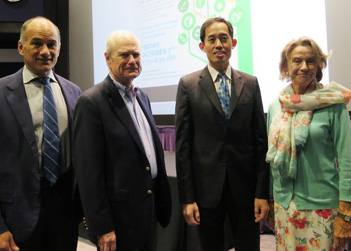BIGELOW LECTURE
Going Green

Wilfred Bigelow
|
Wilfred Gordon Bigelow
was a pioneering cardiac
surgeon who chaired the
Division of Cardiac Surgery
from 1956 to 1977. Dr.
Bigelow’s special contribution
to surgery of the heart
was the use of hypothermia
to slow tissue metabolism
and thus protect the heart
and brain from damage. He began this work with
tedious, but indispensable animal trials and by 1952
he was ready to apply this procedure to patients. At
Toronto, the hypothermia research program led to
another equally important breakthrough for cardiac
surgery - the development of the first implantable
cardiac pacemaker.
(adapted from Cold Hearts by Gunnar Staalesen,
Arcadia Books, 2013)
|
The 2016 Bigeow Lecturer, Joseph Woo serves as
the Norman E. Shumway Professor and Chair of the
Department of Cardiothoracic Surgery at the Stanford
University School of Medicine. He received his undergraduate
degree from the Massachusetts Institute of
Technology and his M.D. from the University of
Pennsylvania where he also obtained his postgraduate
surgical training. At Penn, Dr. Woo also completed
a postdoctoral research fellowship in novel molecular
strategies for attenuating myocardial ischemic injury for
which he won the American Heart Association Vivien
Thomas Young Investigator Award. Dr. Woo joined the
Penn faculty in 2002 as the Director of the Minimally
Invasive Cardiac Surgery Program. He helped to advance
the field of complex valve repair and developed several
innovative new mitral and aortic valve operations. He
also led the Mechanical Circulatory Assist and Cardiac
Transplant Program and has likewise developed novel
LVAD and transplant techniques. Dr. Woo built a robust
practice, performing 350-400 pump cases per year and
was listed in the Philadelphia Magazine as one of the
region’s Top Doctors for several consecutive years. In
2014, Dr. Woo moved to Stanford University to lead the
Department of Cardiothoracic Surgery. Under his leadership,
overall cardiovascular surgical clinical volume,
extramural research funding, and residency education
programs in the Department have grown significantly.

Christopher Caldarone with Joseph Woo and James Rutka
|
Dr. Woo currently runs an NIH R01-funded basic
science research lab studying stem cells, angiogenesis,
and tissue engineering. He is an Associate Editor for the
Journal of Thoracic and Cardiovascular Surgery and has
served as a Guest Editor for Circulation.
Honoring the legacy of Bill Bigelow, Dr Woo presented
an illustrated northern constellation of cardiothoracic
surgical stars trained in Toronto, followed by a southern
constellation of surgeons trained by Norman Shumway at
Stanford. He told us how Shumway, following the lead of
Bigelow in studying hypothermia, included excision and
re-implantation after cold immersion of the heart- this led
to his realization of the feasibility of orthotopic cardiac
transplantation, for which he became the world’s leader.
Woo’s Bigelow lecture entitled “Are Surgeons Going
Green? The Quest for Reconstruction and Renewables”
focused on a series of remarkable advances in the program
at Stanford: doubling of the cardiac surgical volume,
99% repairs rather than replacements for mitral
valve disease, minimal access valve repairs, even on the
beating heart. In an echo of the Keshavjee lab’s ex vivo
resurrection of unsuitable donor lungs for transplantation,
the Stanford surgeons perform ex vivo valve repairs
on donor hearts otherwise considered unsuitable- before
transplanting them. The Stanford surgeons performed
67 heart transplants in 2015.

Christopher Caldarone with Ian Currie, Joseph Woo and Pixie Bigelow Currie
Domino Transplants of the heart and lungs, minimal
access implantation of a tiny intra-cardiac left ventricular
assist device, studies of cardiac regeneration using
stem cells, endoscopic harvest of the radial artery and
construction of multi-pedicled arterial coronary grafts
without touching the aorta were described as part of
the Stanford clinical program. From the laboratory, the
cytokine cyclin for regeneration and primordial bacterial
chloroplast enhancement for oxygenation studies took us
to the leading edge of cardiac surgical research.
Members of the Bigelow family in attendance, Joseph
Woo and host Christopher Caldarone are pictured nearby
celebrating a lecture that would delight Bill Bigelow
MM
|